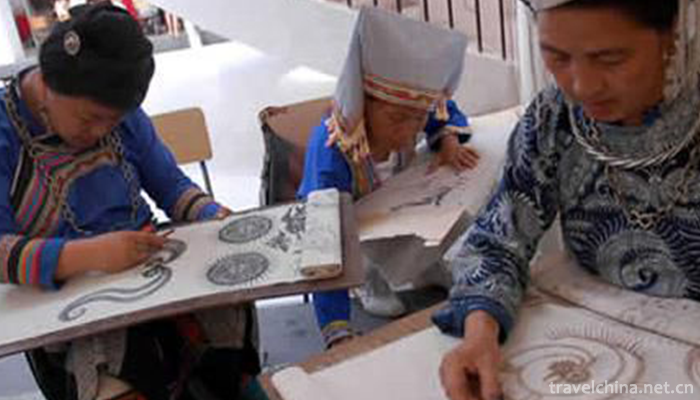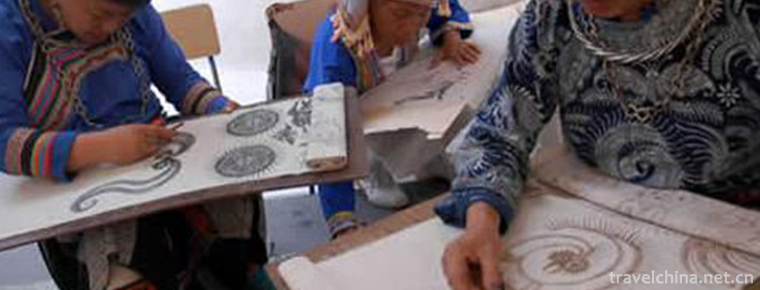Miao Batik Dyeing Techniques
Miao Batik Dyeing Techniques
Miao batik technology, the traditional handicraft of Danzhai County, Guizhou Province, is one of the national intangible cultural heritage.
Batik dyeing is one of the ancient folk traditional printing and dyeing techniques of the Chinese nation. As early as the Qin and Han Dynasties, the Miao people had mastered batik dyeing techniques, and the Song Dynasty reached its peak.
On May 20, 2006, Miao batik technology was approved by the State Council and listed in the first batch of national intangible cultural heritage list, project number_-25.
historical origin
As early as the Western Zhou Dynasty (11th century BC - 771 BC), dyeing and weaving technology in China had been greatly developed. According to the records of Li Ji and other documents, there was an official in charge of dyeing fabrics at that time called "dyeing people". In Chu State, there was also a "blue Yin" official specially responsible for the production of indigo. It is obvious that the silk weaving and dyeing processes at that time were quite large-scale.
Miao batik has a long history, many places are popular with "Batch Dyeing Song" (ancient song), narrating the origin of batik. As early as the Qin and Han Dynasties, the ancestors of the Miao nationality had mastered batik technology. According to the "Tongzhi of Guizhou Province", the batik cloth was once known as "appendix-dry patches" when wax-painted flowers were dyed on cloth.
Wax curtain (batik) was very popular in Wuxi area of Song Dynasty. In Ming and Qing dynasties, Miao people in central Guizhou also used batik clothing. During the period of the Republic of China, batik was prevalent among most Miao people in Western Hunan, Guizhou, Yunnan and southern Sichuan, while Danzhai, Anshun, Langdai (today's six branches), Puding and Huishui were the most skilled places in Guizhou. In most areas, batik products are used as clothing, while in Western Hunan, batik products are used as bed sheets, curtain edges, pillow towels, etc.
Danzhai County, Anshun County and Zhijin County are multi-ethnic inhabited areas with Miao as the main body. In the long-term hardship of isolation from the outside world, the inhabitants here gradually formed a self-sufficient way of life, thus preserving the ancient batik skills. According to Miao custom, all women are obliged to inherit batik skills. Every mother must teach her daughter how to make batik. So Miao women learn this skill from an early age. They grow indigo and plant cotton, spin and weave cloth, paint wax, dye and cut, and inherit it from generation to generation. In this situation, the Miao community has formed a batik art-led costume, marriage Festival rituals, social ways, funeral customs and other customs and cultures.
Inheritance and protection
Inheritance value
Batik dyeing is the earliest printing and dyeing technology used by human beings, which is also known as the "history book on the body". After passing down from generation to generation and continuous creativity, batik now basically breaks the previous design mode and production mode, carries on the creativity with the strong and simple national customs, and embodies the simple mystery of this ancient art.
Inheritance status
The variety of textiles is constantly enriched, and the status of batik as the mainstream textiles in Guizhou Miao area has been shaken gradually. With the development of tourism, batik handicraft products have been marketed as characteristic tourist souvenirs. In order to meet the needs of the market and pursue economic benefits, a large number of poor batik products emerged, which posed a threat to the orderly inheritance of skills. It can be seen that Miao batik technology urgently needs real protection and reasonable development.
Heritage figures
Wang Ayong, female, Miao nationality, born in February 1944, is a visionary villager in Paitiao Town, Danzhai County, Guizhou Province. In May 2006, Miao batik technology was listed in the first batch of national intangible cultural heritage list of traditional skills, project number_-25. In December 2012, Wang Ayong was selected as the representative successor of the fourth batch of national intangible cultural heritage projects and declared in Danzhai County, Guizhou Province. The rural women in Wang Ayong's hometown are almost all batik painters. She learned batik painting from an early age with the old people and her sister. The batik technique is becoming more and more mature. She paints without ruler, without foundation, with bold brush strokes, and works at one go. Flowers, birds, fish and insects in her paintings are vivid, lively and distinct in their traditional patterns and lines. His representative works include "Centennial Whirlpool Batik Dyeing". In 1983 and 1984, Wang Ayong was invited to perform in American wax painting twice. American audiences called her "Oriental Artist" and "Oriental First Dye". Wang Ayong has also been invited to teach art in other places for many times, and founded Danzhai Ayong Batik Dyeing Tourism Culture Company.
protective measures
The state attaches great importance to the protection of batik, a folk handicraft. On May 20, 2006, Miao batik technology was approved by the State Council and listed in the first batch of national intangible cultural heritage list.
In June 2015, a non-heritage protection base with Miao batik as the core was established in Rongshui National Vocational and Technical School. Over the past two years, the base has enrolled more than 100 students in two batches. After school, under the guidance of Mak Hua, the Miao wax dyeing successor, the base has systematically studied the traditional wax dyeing craft and artistic creation.
social influence
With the development of science and technology, Miao batik technology has been further developed on the basis of tradition. As a special commodity, Miao batik technology integrates practicability and artistry. With its unique charm, it rapidly opens up domestic and international markets. Its products are sold to more than 200 cities in China and exported to Japan, the United States, France, Southeast Asia and other countries and regions.


-
1.Boiled Chinese flowering cabbage
Boiled cabbage is a traditional dish in Guangdong province. It is a Cantonese cuisine. This dish is crisp and tender in quality, unique in flavor and rich in nutrition.
Time 2018-11-02 -
2.China of chunqiu yancheng tourist area
China Spring and Autumn Yancheng Tourist Area (also known as Yancheng, Spring and Autumn Yancheng) is located in the central city of Wujin District, Changzhou City
Time 2018-12-06 -
3.Shennong Creek Scenic Area
Shennongxi, originating from the main peak of Shennongjia, flows through Badong County, Hubei Province. It travels from north to south through deep mountain canyons, and converges into the Yangtze Riv
Time 2018-12-12 -
4.XiShuangBanNa Tropical Botanical GardenChines
Xishuangbanna Tropical Botanical Garden of the Chinese Academy of Sciences, National AAAAA Tourist Scenic Area, is located in Huludao, Mengla Town, Mengla County
Time 2018-12-12 -
5.Gongchangling Hot Spring Skiing Ground
Gongchangling Skiing Ground is located in Tanghe Scenic Area of Gongchangling, Liaoyang City, Liaoning Province. It covers an area of 100 hectares and is a national AAA-class tourist attraction.
Time 2019-01-12 -
6.Narati Scenic Spot
Narati Tourist Scenic Area, located in Xinyuan County, Xinjiang, is located in the hinterland of Tianshan Mountains, the eastern end of the Ili Valley, with a total planning area of 960 square kilomet
Time 2019-02-07 -
7.Qingyan Ancient Town
Qingyan Ancient Town, one of the four ancient towns in Guizhou, is located in the southern suburb of Guiyang City. It was built in Hongwu ten years (1378) of Ming Dynasty
Time 2019-02-07 -
8.Korean Huajiali
The flower armor ceremony of the Korean nationality is one of the important rituals of the Korean nationality's birthday ceremony. Since ancient times, the Korean people have regarded respecting the e
Time 2019-04-16 -
9.Shuixiang Opera
Shuixiang opera is a traditional folk cultural activity in Shaoxing, Zhejiang Province. Waterfront theatres are mostly built on rivers in front of temples such as land temples, so they are called &quo
Time 2019-06-16 -
10.Longtouguan
Longtouguan, a cultural relic protection unit in Sichuan Province. Located in Jiangyang West Road, Jiangyang District, Luzhou City, Sichuan Province. Originally an ancient pass, it was built in the Shu Han Dynasty to build a wall for the earth; it was rebuilt in the 11th year of Chongzhen in the Ming Dynasty and rebuilt in the second year of Tongzhi in the Qing Dynasty.
Time 2020-10-16 -
11.Thousand Buddha Cliffside Sculptures
Qianfo cliff, located 4 kilometers north of Guangyuan City, on the East Bank of Jialing River and on the ancient Shu Road of Jinniu, has a long history and exquisite carving skills. The grottoes began in the late Northern Wei Dynasty, flourished in the Tang Dynasty and ended in the Qing Dynasty. After thousands of years
Time 2020-11-08 -
12.Mineral resources in Dazhou
As of 2012, 38 kinds of minerals have been found in Dazhou City, with more than 250 producing areas. Among them, there are 28 proven reserves, 146 producing areas, 28 exploitable and 21 developed. The proven reserves of stone coal are 763 million
Time 2020-12-20